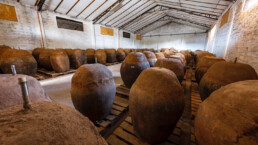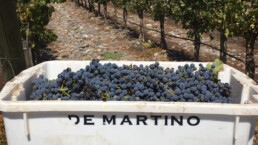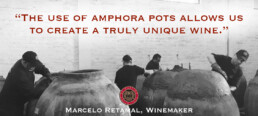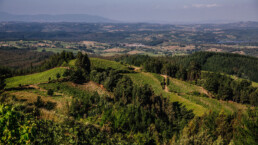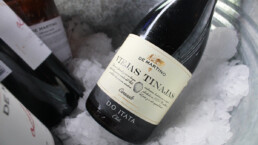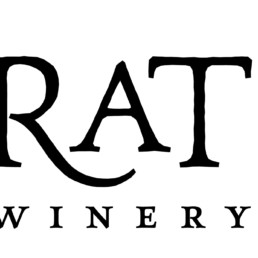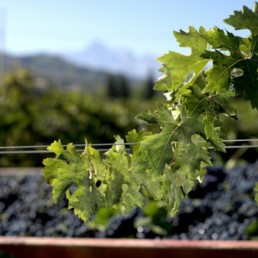Focus On: The Viejas Tinajas Wines of De Martino
What is Old is New again
“De Martino, one of the most dynamic and enterprising among the experimental and entrepreneurial companies in Chile.” – Jancis Robinson
In a world packed with technology and modern advances it seems slightly odd to bring back ancient methods of winemaking. However, that’s exactly what the team at De Martino have done. They’ve been on a mission over the last few years buying up old earthen jars, clay amphorae, or ‘Tinajas’ in Spanish, from all over Chile to bring a great project to life – that of making authentic wine as their ancestors had done, in clay Tinajas.
The De Martino Viejas Tinajas winemaking is harking to a methodology that originated in the first vineyards of the Itata Valley in Chile first planted in 1551. This is a fitting tribute to the first winemakers of the country and to the special Chilean terroir. De Martino now have approximately 150 of these vessels in their care, averaging 150 years each tinaja and making some seriously sexy wines in them.
You may be thinking, has Dhall & Nash suddenly gone all “hipster” on you? Just tai-ho team – time to hear us out without growing a beard and wearing Birkenstock sandals with socks.
Yes, indeed these various types and sizes of clay amphorae – tinajas – have become an emblem of the trendy Natural wine scene. Even though the practice of using these vessels for fermenting and ageing wine originated way back over 7,000 years ago in what is now modern-day Georgia.
Ostensibly, their renaissance can be largely tied to a hands-off, minimal intervention winemaking approach. The growing popularity of these ancient vessels being adopted by winemakers across the globe in recent years has a lot to do with letting the land “talk”, not the hand of man interfering. It seems that younger drinkers are embracing this style as the big blockbuster bruiser of a wine of years past has lost some of its glamour and palate appeal.
So where does De Martino’s Viejas Tinajas fit into the scheme of things? …
De Martino is one of the most progressive and exciting names on the Chilean wine scene, deservedly named Chilean Winery of the Year in 2011. Through a network of partnerships and vineyard acquisition, it has quickly built up a reputation for organic viticulture of the highest quality, farming from over 300 different vineyards sites in 7 Chilean D.O. wine regions. The De Martino family have set their vision on specialising on producing pure, origin-reflective wines, giving you a real sense of where it was made when you crack open the bottle. Their vision focuses on sustainability, terroir, and, by logical extension, real honest excellence.
How much of a difference does a vessel make on your wine?
Beyond the romanticism involved in borrowing ancient techniques, terracotta pots offer unique interactive properties with wine – they pull out acidity, allow oxygen exchange, and provide superior insulation, among other benefits – that are different from those of stainless steel, wood barrels, or concrete.
The simplest way to understand vinification in clay is to compare it to widely used steel and oak. Fermentation and ageing in stainless steel provide an oxygen-free environment where no flavours are imparted into the wine, allowing crisp fruit notes to shine through. Think – good old Savvy.
Whereas oak, in the form of barrels, provides plenty of benefits as well, allowing for ample oxygen to reach the juice, but the wood’s tannins can also affect the aromas and flavours of the wine – especially new oak. Think – rich, oaky Chardonnay.
On the other hand, clay is the happy medium between the two. Like oak, clay is porous, allowing for an exchange of oxygen. Like steel, clay is a neutral material, so it doesn’t impart additional flavours.
Another benefit is due to the tinajas shape as they work like an egg fermenter and always maintain a kinetic state where the fermenting wine is forced into circular motions, a vortex of movement, rising up the concave sides and then falling down the middle. The wines’ continuous motion carries everything in its wake, including the lees. So, no need for extractive bâtonnage (lees stirring).
Unsurprisingly, some people assume that something coming from terracotta is going to be orange or heavy, clunky, or tannic, which is not the case! As the De Martino Viejas Tinajas wines reveal they are complex, textural, bright, and balanced wines. It is the length of time of skin maceration that has more to do with the final texture of the wine than the clay pot itself. And clay’s porosity does mean that tinajas wines develop a rich and deep texture without the “cosmetics” of oak flavour. Proponents say the clay vessel brings the fruit’s vitality and energy to the wine, as well as a purity unmasking an honest expression of the land.
Vina de Martino – “New World Icon of Tomorrow”. – Decanter Magazine (UK), September 2007
The De Martino History:
The patriarch of the De Martino family, Pietro, moved to Isla de Maipo, Chile from Abruzzo, Italy back in 1934. Although he managed to set up the original winery, La Quinta, which was around 10 ha (25 acres) his poor health saw him return to die in Italy in 1944.
He had no children and the property remained semi-abandoned throughout the Second World War. By 1947 Pietro’s nephew Giorgio De Martino (the grandfather of Marco and Sebastián) arrived in Chile along with his mother (Armida, Pietro’s sister) and settled in La Quinta. He was a young man determined to make a living from wine and construction, looking for a better future than the one he left behind in Italy. He started pulling the property back into shape, planting new vineyards, renting others, and building the De Martino dynasty.
Today, the winery brings together the experience of the third generation of the family with the dynamism and vision of Marco Antonio and Sebastián De Martino, the fourth generation. This is complemented by the expertise of winemakers Marcelo Retamal and Eduardo Jordan, to round off the perfect wine-production package.
But it is with the fourth generation that we see De Martino’s vision further evolve. By the mid-2000s a change in the style of the De Martino wines was being envisioned by the winemaking team.
There was a strong feeling that De Martino needed to build a house style of its own, based on the wines the family really liked to drink. By the 2011 harvest, this evolution process was complete, and the style of the wines changed dramatically. In a way, it was a step backwards with the knowledge gained from more than 80 years of winemaking but backed by modern techniques. The goal was to produce more elegant and balanced wines, wines that really show their terroir, with great drinkability, fresh acidity, and moderate alcohols. The use of anything that could mask the wines’ personality was banned from the winery. And the quest to produce the traditional Tinajas wines took off!
Did you know? De Martino has deservedly received many accolades and awards, being named Chilean Wine Producer of the Year in both 2005 and 2009 by the IWSC and is the 1st South American Carbon Neutral winery.
Winemaking Philosophy:
As chief winemaker at De Martino, Marcelo Retamal’s role is to fulfil their vision to create wines that reflect their origin. Their philosophy is based on minimum intervention on single vineyards, including organic and traditional winemaking methods. Wines are crafted with native yeast, balanced in alcohol, and eliminated all new oak to preserve the essence of the vineyards – thinking about it, this was a huge departure for a relatively commercial Chilean winery. It meant having a more hands-on approach to viticulture and a more natural ‘hands-off’ approach to winemaking.
Winemaker Marcelo Retamal has led a process which concentrated on matching grape variety to site with real precision and probably the first terroir-specific range of wines in Chile. This encouraged the family, always looking for the best quality possible, to expand into other wine regions with ancient vineyards such as Itata.
“De Martino are one of Chile’s most exciting wineries. They are doing all the right things.” – Dr. Jamie Goode, Wine Anorak
The Itata Terroir:
Cinsault is an historic grape variety in Chile’s Itata Valley, a beautiful but relatively poor agricultural region. In 2011 the Viejas Tinajas Cinsault really put De Martino, and Itata, on the world wine map when it was first released. This was exciting winemaking exalting an exceptional terroir.
These are old, unirrigated vineyards in the heart of the Coastal Mountain Range, some 400km to the south of Santiago and just 22km from the Pacific Ocean and 174 metres above sea level. It is a rugged hilly zone with a cool maritime climate of good rainfall which allows dry farming of the vineyards. The vineyard is over 50 years old, Gobelet (bush vine) trained, and planted without rootstock, following the traditions of the area. The mostly granitic and loam soils have excellent structure and drainage with 20% clay content; some quartz is also found in the soils of the region.
“There is still a lot of fine tuning to do but we are in a happy place. We know where we are going, we are presenting our landscape and chasing harmony and balance.” – Sebastian de Martino
The Viejas Tinajas Wines:
The first vintage of Muscat was 2013. It is an aromatic and intense wine that achieves a balance between fresh acidity and the texture contributed by lengthy maceration on the skins. Vinification in amphorae contributes a rich texture to the palate and results in a wine with tension, volume, and smoothness.
The Muscat winemaking process: The grapes are de-stemmed and the whole berries placed inside the tinajas. Alcoholic fermentation is carried out by native yeast and the wine remains in contact with the skins for 6 months until malolactic fermentation is complete. The wine is then racked to another tinaja and matured for a further 6 months prior to bottling. There is no fining or filtering.
The first vintage of the ground-breaking Cinsault was 2011.
The Cinsault winemaking process: Once the grapes are de-stemmed, they are fermented in the amphorae for 15 days, undergoing carbonic maceration. The wine spent the entire winter in the tinajas and then in spring, once malolactic fermentation was complete, the wine was bottled without filtering. It is worth noting that no winemaking products (artificial enzymes or yeasts) were added, except for a small quantity of sulphur dioxide at bottling to preserve the wine during transport.
2018 De Martino Viejas Tinajas Muscat
“This spends 6-7 months on skins, and the only SO2 addition is a little before bottling. Beautiful aromatics: floral, passionfruit, grapefruit, some table grapes. The palate has lovely fruit with grapey richness but also citrus and a hint of earthiness from the tinaja. So pretty, layered, and complex.” 93/100 points, Wine Anorak
2018 De Martino Viejas Tinajas Cinsault
“This is precise, expressive and fresh, with a wild character, very different from the other Cinsaults. It has a brothy, meaty touch on the palate that makes it very tasty. Clean and precise, with very good grip, 2018 has to be the finest vintage to date for this wine.” 93-94/100 points, Robert Parker’s Wine Advocate (LG)
“This is a beautiful wine that shows fresh raspberries, citrus, herbs and hints of terracotta and iron. Medium-bodied with a lovely, steely texture, presented by medium-chewy tannins and loads of fresh red fruit. Purity is the calling card here.” 94/100 points, James Suckling.
“100% Cinsault. Old vines. Vineyards located near the sea, although the winery is in Santiago de Chile. Fermented and aged in old earthenware jars. Neither oenological products nor commercial yeasts were used. Open wine (herbal, black but delicate fruit, complex). Very well done, with freshness and finesse. I love it! It has a mineral expression, with a soft palate and floral flavours. Spicy and delicate finish, a wonderful Cinsault!” 18/20 points, Jancis Robinson
“Supple and fine with lively herb and red cherry aromas. Nice fine-grained red cherries and herbs here with a sappy edge and fine-grained red cherries and herbs. Has a sappy edge with fine green hints. Real elegance with a lovely mouthfeel: supple and delicious.” 94/100 points, Wine Anorak
De Martino has arguably undergone one of the more radical transformations the wine world has seen in the past decade. They have spearheaded Chile’s new wave of winemaking and wine appreciation. This is a story of a family driven to make lusciously authentic wine by using traditional tinajas after being disillusioned by over-manipulated, over-extracted formulaic wines with no regional connection. The De Martino wines are artisanal, honest, elemental.
These Viejas Tinajas wines will WOW you with their energy embodied in bright, juicy fruit, nuanced layers, and crisp, crunchy texture. ‘Hipster up’ wine lovers, it’s time to have your mind blown and your heart expanded by these unique vinous jewels!
